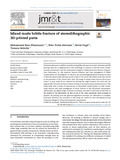Citation link:
https://doi.org/10.1016/j.jmrt.2023.06.175| DC Field | Value | Language |
|---|---|---|
| crisitem.author.orcid | 0000-0001-8926-2346 | - |
| crisitem.author.orcid | 0000-0003-0896-7083 | - |
| dc.contributor.author | Khosravani, Mohammad Reza | - |
| dc.contributor.author | Frohn-Sörensen, Peter | - |
| dc.contributor.author | Engel, Bernd | - |
| dc.contributor.author | Reinicke, Tamara | - |
| dc.date.accessioned | 2023-12-12T08:18:51Z | - |
| dc.date.available | 2023-12-12T08:18:51Z | - |
| dc.date.issued | 2023 | de |
| dc.description | Finanziert aus dem DFG-geförderten Open-Access-Publikationsfonds der Universität Siegen für Zeitschriftenartikel | de |
| dc.description.abstract | Technical advances in additive manufacturing (AM), also known as three-dimensional (3D) printing, have led to applications of this technology in creation of end-use items. Consequently, performance and the mechanical strength of AMed parts have become of significant importance. In this research, fracture behavior and crack propagation of AMed cracked plates are investigated. To this aim, the stereolithography (SLA) technique is used to fabricate square plate specimens with a hole in the center and radial cracks that started at the perimeter of the central hole. Here, full range of mixed-mode fracture (from pure mode I to pure mode II) are obtained by altering the angle between the crack and the applied load. We used the finite element method to determine stress intensity factors. This study deals with a series of experiments on 3D-printed cracked plates to study mixed-mode fracture and crack propagation in brittle fracture of SLA 3D-printed components. Additionally, the digital image correlation technique was used to determine strain field on the surface of the specimens. As SLA is one of the most commonly used concepts in polymer 3D printing and has garnered significant attention for fabrication of complex structural elements, the outcomes of this study are useful for next developments and innovative designs of 3D-printed polymeric components. | de |
| dc.identifier.doi | https://doi.org/10.1016/j.jmrt.2023.06.175 | de |
| dc.identifier.uri | https://dspace.ub.uni-siegen.de/handle/ubsi/2571 | - |
| dc.identifier.urn | urn:nbn:de:hbz:467-25712 | - |
| dc.language.iso | en | de |
| dc.rights | Attribution-NonCommercial-NoDerivatives 4.0 International | * |
| dc.rights.uri | http://creativecommons.org/licenses/by-nc-nd/4.0/ | * |
| dc.source | Journal of materials research and technology ; 25, S. 3177-3188. - https://doi.org/10.1016/j.jmrt.2023.06.175 | de |
| dc.subject.ddc | 620 Ingenieurwissenschaften und zugeordnete Tätigkeiten | de |
| dc.subject.other | Additive manufacturing | en |
| dc.subject.other | Mixed mode I/II | en |
| dc.subject.other | Fracture | en |
| dc.subject.other | SLA | en |
| dc.subject.other | DIC | en |
| dc.subject.other | Additive Fertigung | de |
| dc.title | Mixed mode brittle fracture of stereolithographic 3D-printed parts | en |
| dc.type | Article | de |
| item.fulltext | With Fulltext | - |
| ubsi.publication.affiliation | Department Maschinenbau | de |
| ubsi.source.doi | 10.1016/j.jmrt.2023.06.175 | - |
| ubsi.source.issn | 2214-0697 | - |
| ubsi.source.issued | 2023 | de |
| ubsi.source.issuenumber | 25 | de |
| ubsi.source.pagefrom | 3177 | de |
| ubsi.source.pageto | 3188 | de |
| ubsi.source.publisher | Elsevier | de |
| ubsi.source.title | Journal of materials research and technology | de |
| Appears in Collections: | Geförderte Open-Access-Publikationen | |
Files in This Item:
| File | Description | Size | Format | |
|---|---|---|---|---|
| Mixed_mode_brittle_fracture_of_stereolithographic_3D-printed_parts.pdf | 3.7 MB | Adobe PDF |  View/Open |
This item is protected by original copyright |
Page view(s)
336
checked on Apr 12, 2025
Download(s)
71
checked on Apr 12, 2025
Google ScholarTM
Check
Altmetric
This item is licensed under a Creative Commons License


